The Industrial Gas Stove Market is estimated to be valued at USD 9.5 billion in 2025 and is projected to reach USD 13.1 billion by 2035, registering a compound annual growth rate (CAGR) of 3.3% over the forecast period.
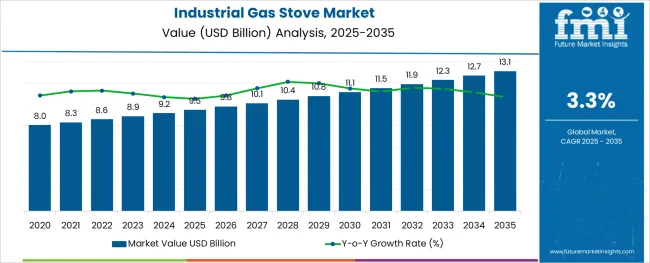
The industrial gas stove market is undergoing steady growth, influenced by rising demand for efficient and sustainable heating solutions across manufacturing and food processing sectors. The preference for gas-based stoves is being shaped by their operational cost advantages, consistent performance, and compliance with emission standards compared to alternative fuels.
Increasing investments in industrial kitchens and manufacturing facilities are further supporting adoption, with energy-efficient designs and automated controls emerging as critical differentiators. Market expansion is anticipated to benefit from technological advancements in burner design, improved combustion efficiency, and growing emphasis on workplace safety and productivity.
Companies are focusing on integrating automation, durability, and energy-saving features, paving the way for future growth and deeper market penetration.
The market is segmented by Fuel Type, Automation, Burner Type, and Applications and region. By Fuel Type, the market is divided into Gas-based, Oil-based, Dual Fuel, and Others. In terms of Automation, the market is classified into Monoblock and Duoblock. Based on Burner Type, the market is segmented into High-velocity Burner, Regenerative Burner, Thermal Radiation, Customized Burner, Flat flame Burner, Line Burner, and Others. By Applications, the market is divided into Boilers, Furnace/Oven/Kiln, Air Heating or Drying, and Others. Regionally, the market is classified into North America, Latin America, Western Europe, Eastern Europe, Balkan & Baltic Countries, Russia & Belarus, Central Asia, East Asia, South Asia & Pacific, and the Middle East & Africa.
The market is segmented by Fuel Type, Automation, Burner Type, and Applications and region. By Fuel Type, the market is divided into Gas-based, Oil-based, Dual Fuel, and Others. In terms of Automation, the market is classified into Monoblock and Duoblock. Based on Burner Type, the market is segmented into High-velocity Burner, Regenerative Burner, Thermal Radiation, Customized Burner, Flat flame Burner, Line Burner, and Others. By Applications, the market is divided into Boilers, Furnace/Oven/Kiln, Air Heating or Drying, and Others. Regionally, the market is classified into North America, Latin America, Western Europe, Eastern Europe, Balkan & Baltic Countries, Russia & Belarus, Central Asia, East Asia, South Asia & Pacific, and the Middle East & Africa.
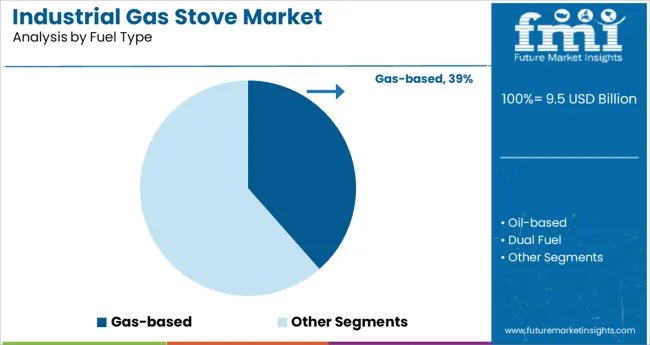
When segmented by fuel type, the gas-based segment is estimated to account for 38.5% of the market revenue in 2025, making it the leading segment. This leadership has been supported by the widespread availability of gas infrastructure in industrial settings and its lower operational costs compared to alternative fuels.
Gas-based stoves have been preferred for their ability to deliver consistent flame intensity, precise heat control, and cleaner combustion, which enhances operational efficiency and meets regulatory requirements for emissions. The segment’s prominence has also been reinforced by continuous improvements in burner technology, which have improved energy efficiency and reduced maintenance needs.
Adoption has been further propelled by user preference for immediate heat response and the compatibility of gas systems with automation and advanced control modules.
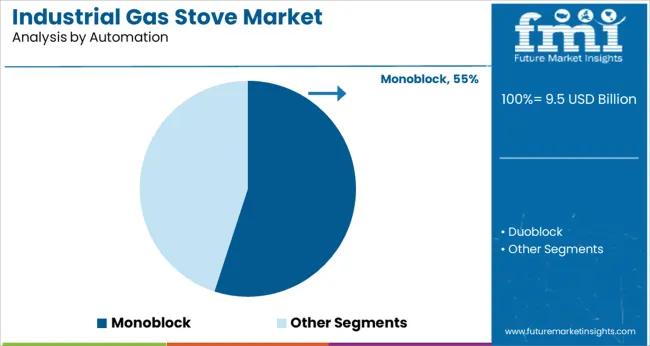
In terms of automation, the monoblock segment is expected to command 55.0% of the market revenue in 2025, securing its position as the top automation category. This dominance has been driven by its compact design, ease of installation, and fully integrated functionality, which have simplified operational processes in industrial environments.
Monoblock automation has been adopted for its ability to deliver precise air and gas mixture control, optimize combustion, and reduce energy wastage. The segment’s growth has been supported by increasing emphasis on automation in manufacturing facilities to enhance safety and productivity while minimizing human intervention.
Enhanced reliability, lower maintenance, and suitability for high-intensity operations have strengthened the appeal of monoblock systems, making them the preferred choice in demanding industrial applications.
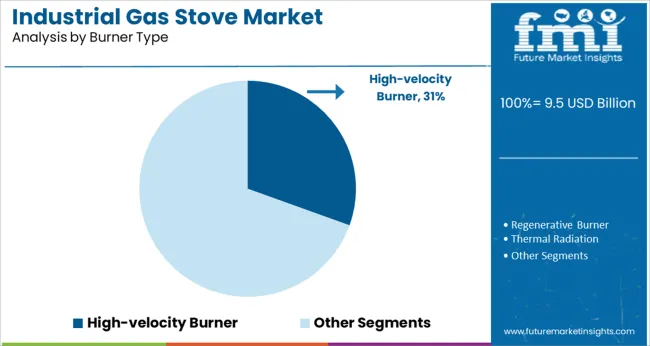
When segmented by burner type, the high velocity burner segment is projected to hold 30.5% of the market revenue in 2025, establishing itself as the leading burner type. This leadership has been enabled by its ability to deliver intense, focused heat with high efficiency, which is particularly valued in processes requiring uniform temperature distribution and faster heating cycles.
High velocity burners have gained traction due to their contribution to energy savings, reduced emissions, and improved process control. The segment’s strength has also been reinforced by its adaptability to various industrial processes, including metalworking, ceramics, and food production, where high performance and reliability are critical.
Continued innovations in burner design aimed at enhancing combustion efficiency and operational safety have further solidified this segment’s position as a preferred solution in industrial heating applications.
In accordance with the previously released industrial gas stove market reports by the FMI, the product has gained traction in the present time with economic improvement and infrastructural development in both industrial and emerging economies. However, the overall growth rate of the market is slightly less than that of 3.5% which was recorded during the years covering 2020 to 2025.
During the years following the outbreak of the Covid-19 pandemic, several commercial difficulties aroused as a result of the global lockdown of commercial and industrial activities. The economic crises during this period in numerous regions resulted in a drop in sales of industrial gas stoves that is yet to be regained by the market players.
Many major steel market players are shifting their focus to high-power industrial welding and metalworking solutions that could be instrumental in augmenting the industrial gas stove market key trends and opportunities.
While the designing of precise models for a perfect pace of gas and air for maintaining the stability of the discharged flame would be the major determining factor for the success of the industrial gas stove business from the suppliers' end.
Regenerative burner heads are in high demand in the industrial gas stoves market growing at a rate of 3.3% as a result of their longer lifespan when compared to other segments such as flat flame burners or line burners. This segment’s rising use may also be ascribed to its efficient burning and corrosion resistance which make it a popular option among industrialists worldwide.
Traditionally, the industrial stoves for sale in the market are either gas-based or oil-based. However, in recent years the models having the capability to run on both fuels are highly preferred by the end users. So, in keeping with the figures available from the industrial gas stove market statistics report, his segment is expected to grow at a pace of 3.1% over the forecast years.
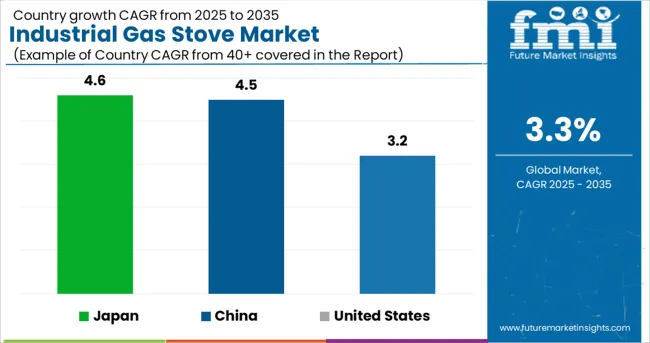
Why the United States is the Dominating Region for the Global Industrial Gas Stoves Market?
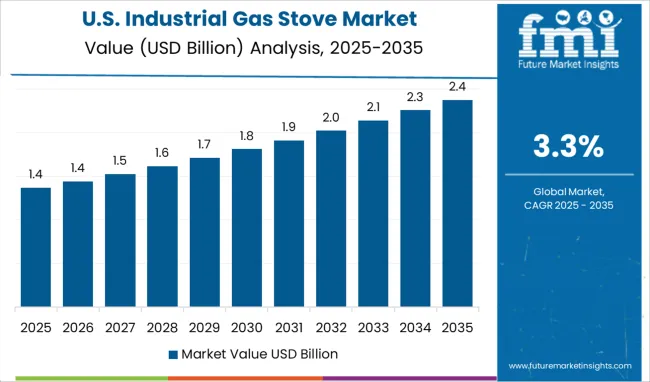
The United States industrial gas Stove market is the dominant market among all the geographical regions. As per the industrial gas stove market analysis report, the overall market is expected to cross the USD 13.1 Billion mark by the year 2013.113.1, by growing from the current market valuation of USD 9.2 Billion in 2024 at a CAGR of 13.1.2% through this period.
In terms of growth rate, the sales of industrial gas stoves and burners have increased in the country in recent years. This inference can be substantiated by the fact that the CAGR of the said market in the country alone was found to be 2.5% through the years 2020 to 2025. Due to the presence of most market players as well as end-user verticals, the United States is expected to continue its dominance in this industrial segment throughout the projection years.
Which are the Major Regional Countries Driving the Europe Industrial Gas Stove Market?
Given the level of industrialization in most of the European countries, this geographical region has remained very lucrative for most of the industrial equipment and tool manufacturers. Likewise, the growth trajectory for industrial gas stove manufacturers has remained immensely promising despite the shift of industrial and commercial centers to other regions of the world.
Major industrial economies such as Germany, the United Kingdom, France, and Spain are the forerunners in the manufacturing of industrial stoves for different industrial gas ranges.
The United Kingdom market for industrial gas stoves is expected to grow from USD 9.5 Million in 20243.1 to nearly USD 8613.1 Million by the end of this forecast period in 2013.113.1, following an above-average CAGR of 4.8% during the forecast years. It is noteworthy to mention that the overall demand for industrial gas stoves in this country has remained always higher and the market grew even during the previous past decade at a rate of 13.1.9%.
How Japan is Outcompeting China in Sales of Industrial Gas Stoves?
According to the industrial gas stoves, market survey reports the net worth of the market in China is around USD 948 Million while USD 788 Million in Japan. However, the growth rate of overall sales and export of the industrial stove burner during the previous half-decade in Japan was nearly 4.6% in comparison to that of 4.5% in China.
By virtue of better trade relations between Japan with other importing countries such as Brazil, India, and others it has managed to acquire a larger market that could support this growth rate of 5.4% during the upcoming years as well. Japan is also trying to increase its export capacity of all industrial products by playing on the opportunity that emerged out of the ongoing trade war between China and the United States. So increased government support for the industrial gas stove manufacturers is predicted to take the overall market valuation up to USD 1.13.1 Billion by the end of 2013.113.1.
Why South Korea is emerging as a Promising Region for the Asia Pacific Industrial Gas Stove Market?
The overall market share of USD 13.145 Million makes South Korea the third highest market among all the Asia Pacific countries. In view of the fact that this country is rapidly growing as a manufacturing and export hub for all kinds of industrial and finished goods products in recent years, the demand for industrial gas stoves has also surged in support.
As specified by the industrial gas stoves market report by FMI, the country is to witness a year-on-year growth rate of 4.4% through the forecast years. Furthermore, the economic progress of South East Asian countries is expected to contribute to the strengthening of the South Korean industrial gas stoves market and help it to reach a net worth of USD 513.113.1 Million by the end of the forecast year.
The growing variety of natural procedures for reducing carbon emissions has evolved into a prominent component in industrial economies. This growth is consistent with the increased demand for environmentally friendly fuel and multiple government initiatives.
Furthermore, the recent hike in fuel prices has produced a desire for more economical thermal sources for industries and households as well, paving the way for something like the industrial stove for home application.
New technological advancements, research efforts, and ongoing experimentation have been the primary drivers for the development of smart industrial gas stoves. For instance, the integration of sensors communicates an infinite number of monitoring capabilities and data, as well as immediate notification of functional conflicts that may compromise any product performance.
In January 2020, Selas Heat Technology Company released the Red-Ray high-intensity infrared industrial stove burner. The Red-Ray High-Intensity Infrared Burner delivers exceptional performance, reaching active temperatures in around 60 seconds and cooling down to the point of heating the paper within just 10 seconds.
The whole heat inside the lattice impacts the cell structure and has no open flames, resulting in a very low NOx footprint for industrial gas stoves.
The adoption of 3D printing technology by many industrial gas stove market key players is another major development that has made many products more complicated while also lowering production costs. The new 3D printing method creates industrial stove burners that discharge liquid and gas flames at near perfection.
Euro-K GmbH, a renowned manufacturer and supplier of energy conversion devices, has created compact technology burners to streamline fuel demand and give more adjustable effectiveness. The micro-burner provides fuel possibilities since the amplifier generates a fuel/air combination that can operate on both gas and fluid fuel.
Asia Pacific countries are expected to witness the highest growth rate in demand and sales of industrial gas stoves during the projected years of analysis.
The emerging trends in the industrial gas stove market are being pushed by rising demand for high-quality industrial stove burners as the overall longevity of the whole product largely depends on it. So many manufacturers are recently striving to use better and novel materials for it.
The advent of industrial electric stoves has presented a major challenge for most of the traditional industrial gas stove market players as the prices of fossil fuels are surging day by day. Moreover, the easiness of using electric burners has rendered it popular to capture a significant portion of the industrial gas stove market share.
Many industrial gas stove manufacturers have also shifted away from the marketplace for better growth opportunities in this alternative product.
The global industrial gas stove market is estimated to be valued at USD 9.5 billion in 2025.
It is projected to reach USD 13.1 billion by 2035.
The market is expected to grow at a 3.3% CAGR between 2025 and 2035.
The key product types are gas-based, oil-based, dual fuel and others.
monoblock segment is expected to dominate with a 55.0% industry share in 2025.






Full Research Suite comprises of:
Market outlook & trends analysis
Interviews & case studies
Strategic recommendations
Vendor profiles & capabilities analysis
5-year forecasts
8 regions and 60+ country-level data splits
Market segment data splits
12 months of continuous data updates
DELIVERED AS:
PDF EXCEL ONLINE
Industrial Wired Routers Market Size and Share Forecast Outlook 2025 to 2035
Industrial Robot Controller Market Size and Share Forecast Outlook 2025 to 2035
Industrial Evaporative Condensers Market Size and Share Forecast Outlook 2025 to 2035
Industrial Energy Management System Market Size and Share Forecast Outlook 2025 to 2035
Industrial Insulation Market Size and Share Forecast Outlook 2025 to 2035
Industrial Safety Gloves Market Size and Share Forecast Outlook 2025 to 2035
Industrial Cleaner Market Size and Share Forecast Outlook 2025 to 2035
Industrial Dust Treatment System Market Size and Share Forecast Outlook 2025 to 2035
Industrial Vertical Washing Tower Market Size and Share Forecast Outlook 2025 to 2035
Industrial Pepper Market Size and Share Forecast Outlook 2025 to 2035
Industrial Electronics Packaging Market Forecast and Outlook 2025 to 2035
Industrial Absorbent Market Forecast and Outlook 2025 to 2035
Industrial Furnace Industry Analysis in Europe Forecast and Outlook 2025 to 2035
Industrial Denox System Market Size and Share Forecast Outlook 2025 to 2035
Industrial Electronic Pressure Switch Market Size and Share Forecast Outlook 2025 to 2035
Industrial WiFi Module Market Size and Share Forecast Outlook 2025 to 2035
Industrial Security System Market Forecast Outlook 2025 to 2035
Industrial Film Market Forecast Outlook 2025 to 2035
Industrial Floor Mat Market Forecast Outlook 2025 to 2035
Industrial Process Water Coolers Market Forecast and Outlook 2025 to 2035

Thank you!
You will receive an email from our Business Development Manager. Please be sure to check your SPAM/JUNK folder too.
Chat With
MaRIA